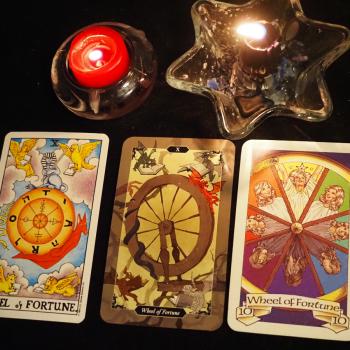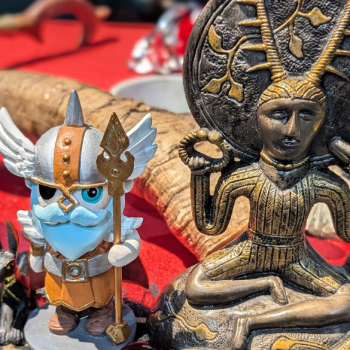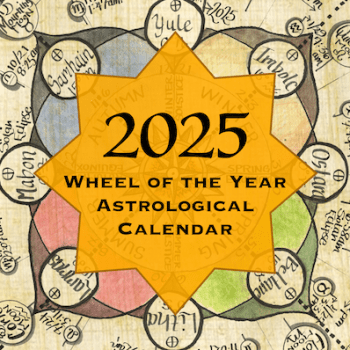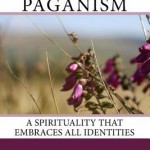Tradition is something that grows and evolves. It is not set in stone, but is more like a discourse; if you start with a particular set of premises, ideas and values, you will get further ideas and practices that are consistent with the initial set of ideas. Religious traditions evolve according to social, cultural, and political circumstances. For example, a Catholic community in India had the tradition of having a procession in honour of the Virgin Mary. It was a particular honour to carry a special flag in the procession, and to raise and lower the flag on the special flagpole. This meant that more people wanted to have the honour than could be accommodated by a single flag and a single raising of the flag. So more flags were added to the procession, and more occasions of raising and lowering the flag were added, till over the years, the original custom was elaborated by considerable additional flags and flag-raising. There’s an example of a tradition evolving.
In a comment on a previous post, Erin wrote:
‘Tradition’ is the accumulation of what others in the past have experimented with to create what will feel like a meaningful experience, whether it is designed to ‘work,’ ‘feel good,’ create connections, or speak through specific symbolic language and action to the powers of choice. ‘Tradition’ does not even necessarily mean set in stone, as personal experiences allow one to gather information which might lead to tinkering and tweaking of said traditions in order to evolve them. Following tradition means attempting to understand how it was created and why, to discern what is language is, and learn how to speak it, to see for oneself if the results are as they are claimed to be. When experiences fall short, the knowledge gained can be added to the accumulated mix that has created tradition thus far, adding a new dimension to it. It is meant to be a living thing preserved by a people which speaks a uniquely meaningful language to them, carried with thanks to those who came before who contributed what they did, and carried carefully to those who will come after, as an important legacy of what has been known and created up to that point.
This is an excellent summary of the organic and evolving nature of tradition.
Some people think that tradition is rigid and unchanging (or that it ought to be so), but this is not the case. Some people also think that saying “because it’s traditional” is sufficient reason for doing a thing. But because tradition evolves in response to circumstances, and because customs can sometimes be harmful, saying “because we’ve always done it that way” is not a sufficient reason for doing something. First we need to consider why it was done that way in the first place. If the reason for doing it that way is still valid, then that’s not a problem. But if there is a new group of people to be taken into consideration (who weren’t considered when the custom was first devised), then we may need to adapt or drop the custom in order to accommodate them.
Folklorists pay attention to the transmission and context of a tradition, as well as to its content. The means of transmission is also important in Pagan traditions. In Wicca, the validity of an initiation is important (it has to be done by someone who is already initiated, and it must be done according to certain criteria). In reconstructionist and polytheist traditions, some people think it is important to have a cultural or ethnic connection to the religion being reconstructed; others derive the legitimacy of their practice from ancient texts about their religion, mythology and deities. Before a new insight (an Unverified Personal Gnosis) can be more widely adopted by practitioners, it needs to be compared to textual evidence, and/or substantiated by comparison with insights from other contemporary practitioners. It then becomes a substantiated personal gnosis.
In Native American religion, the transmission and context of tradition is incredibly important. They would argue that you cannot take their traditions out of the context of people, language, and land where they arose. It is certainly true that when these traditions are taken out of their context and borrowed indiscriminately, with little understanding of what they mean, it is usually cultural appropriation, which erases the identity of the keepers of the original tradition, and can be actively harmful.
That is not to say that you can never adopt a tradition that does not relate to your ethnic background; it does mean that in order to be respectful towards that tradition, you need to study it in depth and respect its original sources and context. If it is possible to receive transmission of that tradition from one of its keepers, then so much the better.
However, if an aspect of the tradition that you have received is actively harmful, then it is legitimate to change it, in my view. An obvious example is the tradition of marriage. In the past, the definition of marriage included polygamy. Some people regarded this as injurious to the individuality of the additional wives, and so polygamy became widely frowned-upon. It also included a woman being required to marry a man who raped her; this was obviously harmful, so the practice has been discontinued in most cultures. Until the early 20th century, it was extremely difficult to obtain a divorce, which meant that many people were trapped within failed marriages; again, this was regarded as harmful, so marriage was redefined as something that could be terminated. Currently, many same-sex couples are harmed by their exclusion from the possibility of being married, so they want the law changed so they can get married. Some have argued that this is a redefinition of marriage; maybe it is, but marriage has been redefined many times before, and it’s still popular. The story of the evolution of marriage shows that it is possible to modify a custom to include more people, or to reduce the harm that it may cause, without changing the basic features of the tradition.
















